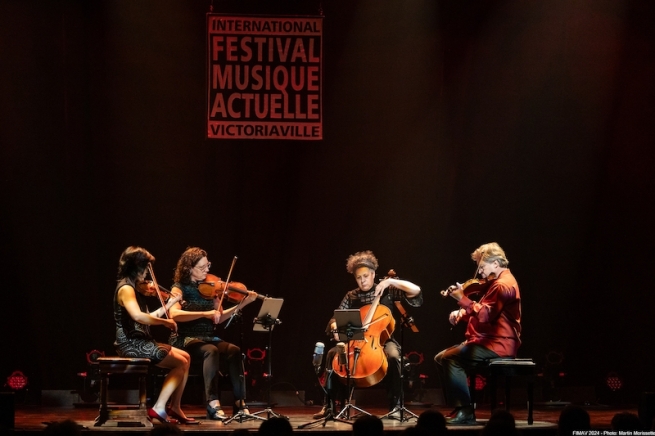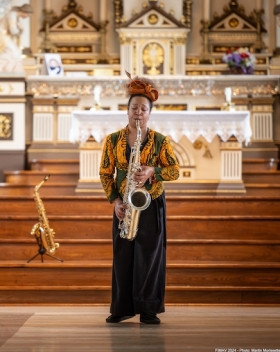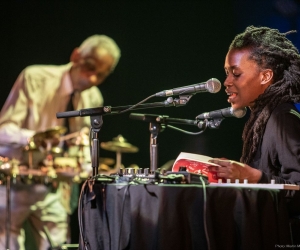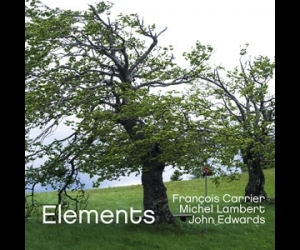The extraordinary nature of Festival International de Musique Actuelle de Victoriaville (FIMAV) came into sharp focus this year. Last year Michel Levasseur announced his retirement as artistic and general director of the festival, which he founded and shepherded through thirty-nine editions. Set in a town of 48,000 people, 150 kilometres from Montreal, FIMAV attracts audiences of free jazz, avant rock, ambient electronica, and harsh noise. Every practicality conspired against Levasseur’s vision, yet over the years he attracted support and managed to build an institution that imaginatively balances diverse genres of music to attract distinct audiences. Formerly housed in a hockey arena, a rundown movie theatre, and a community college’s auditorium, the festival now takes place in the new Carré 150 theatre and cabaret, a convention centre, and a beautifully restored church. An integral part of the community, the festival also displays interactive sound sculptures in the downtown core.
The fortieth edition marked Montreal-based trombonist Scott Thomson’s debut as artistic and general director. His programming background includes founding (in 2007) and curating the Toronto performance space Somewhere There, and a seven-year run as artistic director of the Guelph Jazz Festival. He has also performed frequently at FIMAV.
While a generational shift was inevitable, some traditions have remained firmly in place, including that of the festival opening and closing with large-scale, populist music. This year Montreal composer Pascal Germain-Berardi conducted over fifty musicians and singers in his extended choral drama Basileus, which featured costumed soloists, video title cards, the bestial roar of the Growlers’ Choir, and an orchestra that included a dozen classical guitars; at the festival’s finale, Kim Myhr’s Sympathetic Magic had four guitarists, three percussionists, and keyboardist Eve Risser prepare a warm bath of densely resonant, tuneful music. The large-scale theme was also apparent in Bill Orcutt’s Guitar Quartet with Ava Mendoza, Wendy Eisenberg, and Shane Parish, all playing chiming, highly rhythmic music that could sway toward cathedral and raga.
FIMAV’s steadfast openness to novel musical forms will likely expand under Thomson’s watch, as showcased in this year’s programming. In the experimental jazz-rap ensemble Sélébéyone, saxophonist and leader Steven Lehman and fellow saxophonist Maciek Lasserre added sequencing to the mix, which included drummer Damion Reid, and MCs Hprizm and Gaston Bandimic rapping in English and Wolof, respectively. The most intense and challenging music of the festival came from the trio of Chicago producer, electronic musician, and DJ Kavain Wayne Space improvising with the duo XT (drummer Paul Abbott and alto saxophonist Seymour Wright), whose investigation of classic Chicago R&B and hip-hop rhythms combined Kavain’s thick, propulsive overlays of short samples with Abbott’s dense drumming and Wright’s intense squawks, squeals, yips, and cries. The shock of the new is also a great tradition. Kavain and XT’s visceral ninety-minute epic forced us to address its elements—our constant exposure to the musical, the found, the mechanical, the noise, as well as the instant pleasure of the R&B artifact versus the insistent human presence of the saxophone and drums—a combination of nostalgia and dread that eventually grew ecstatic.
Nate Wooley’s Columbia Icefield—a quartet with guitarist Ava Mendoza, steel guitarist Susan Alcorn, and drummer Ryan Sawyer—performed a new work dedicated to the music and memory of Wooley’s late friend and mentor Ron Miles. The work began with an unaccompanied trumpet solo that had the hollow, quavering longing of a Japanese shakuhachi before moving through multiple dimensions in which each quartet member was featured in a distinct segment. It ended with Wooley playing an unaccompanied version of Albert Ayler’s Ghosts, filled as much with light as loss.
A standout series presented at Saint-Christophe d’Arthabaska church (a miracle of resonance built in the 1870s) featured three brilliant advocates for solo winds. French saxophonist Sakina Abdou used the church as an echo chamber and amplifier in a powerful program that began from the balcony with high-pitched cries and moved to the altar for a series of sustained multiphonic bursts; their effect was beyond description. Spanish saxophonist Don Malfon used various techniques (circular breathing, various-sized cups) to create symphonies of acoustic feedback, suggesting a bank of oscillators. New Brunswick-based trumpeter Nicole Rampersaud engaged the space and the audience with circular breathing and cascading runs. Roscoe Mitchell, another wind soloist of note, explored contrasting sonics on bass and sopranino saxophones as part of the Carré 150’s Cabaret series.
Among the Carré 150 concert hall presentations, two stellar improvised sets matched chamber music dynamics to utterly different methodologies. Saxophonist John Butcher explored a brilliant inventory of overlaid percussive and avian effects alongside pianist Sophie Agnel’s orchestral mastery of the piano’s interior. The recently formed Roaring Tree—the trio of bassist Joëlle Léandre, violist Mat Maneri and pianist Craig Taborn—worked much closer to traditional lines and timbres in an ideal synthesis of late-modernist European precision and free-flowing, emotion-rich improvisation.
Rich musical detailing was apparent in the Montreal-based string quartet Quatuor Bozzini’s performance of Jürg Frey’s String Quartet No. 4, a supremely subtle work in which short, melodic phrases continuously resist easy resolution and special emphasis is placed on the texture of individual bow strokes. An eight-member version of Joshua Abrams’ Natural Information Society performed Since Time Is Gravity, an engaging work of polyrhythmic minimalism, with tenor saxophonist Ari Brown as principal soloist. In this performance, alto saxophonist Mai Sugimot's evanescent melodic detailing, suggesting Eric Dolphy, stood out in a brief solo.
FIMAV's fortieth edition sat squarely in the event's tradition of presenting sometimes challenging, sometimes transcendent, almost always spirited music.
Photos by Martin Morissette.
Top Photo: Montreal's Quatuor Bozzini performs Jürg Frey's String Quartet No. 4 at FIMAV 2025.
Bottom Photo: French saxophonist Sakina Abdou.




